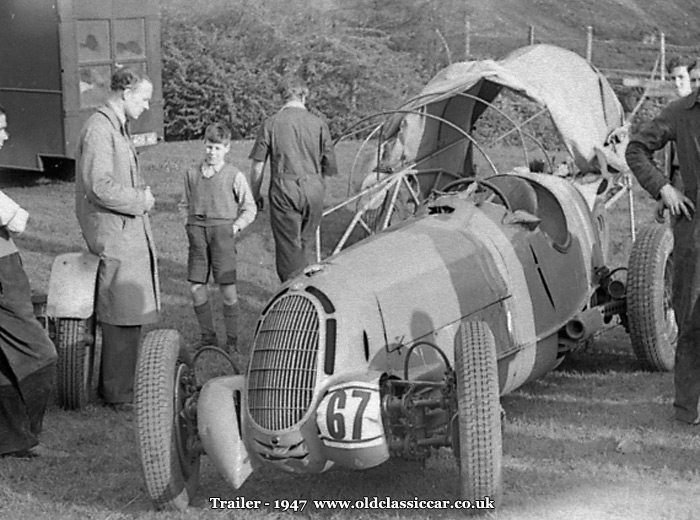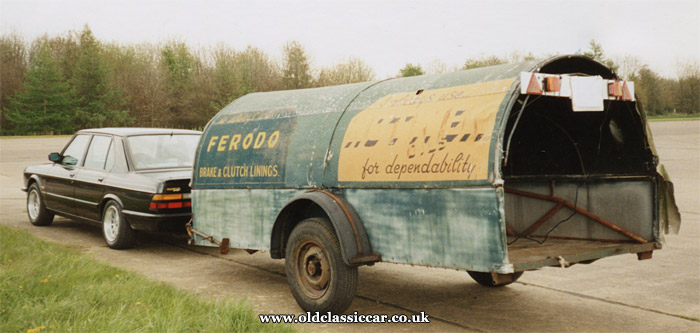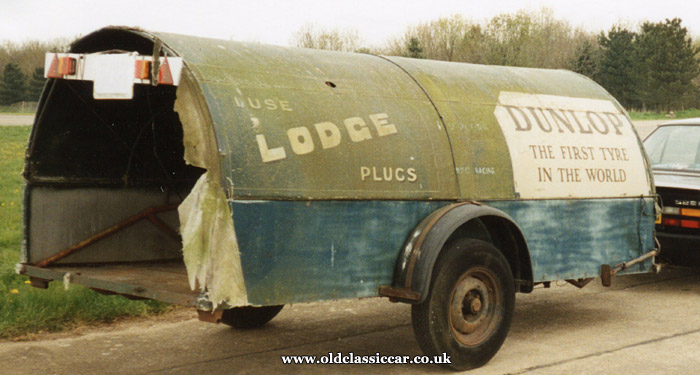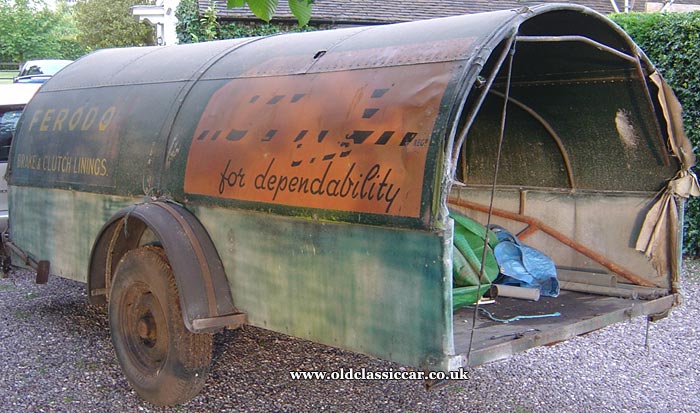Pre-war enclosed racing car trailer.
Return to the main Dodge Restoration page.
|
|
The trailer was designed by Dennis Poore as a high-speed method of trailering his racing cars around the country. According to his chief mechanic, Bill Lawes, who I met on a couple of occasions in the late 1990s, it was tested up to a speed of 97 mph. Whether this was on a convenient length of A-road, or on a quiet runway, I'm not quite sure. I also cannot be sure of the tow-car used for the task - it would have needed plenty of grunt. Prior to WW2, Poore was a demonstration driver for Atalanta Motors, a low-volume producer of very smart, powerful, four- and twelve-cylinder motor-cars. The V12 Atalantas were advertised as being capable of 100+ mph. Perhaps the trailer was attached somehow to a development car, in order to test the trailer's high-speed characteristics? The answer to this will probably remain lost in the mists of time.
|
|
My understanding is that the trailer was born in the 1930s. Poore raced a couple of MGs at weekends prior to WW2, and I think it was for hauling an MG that the trailer was built. To tow it, he acquired a V8 Ford convertible, removed the rear end of the bodywork, and fitted a box body which was used as a mobile workshop and spare parts store. The Ford also appears in a number of early post-war photographs of the Alfa. This confirms that the pre-war Ford and trailer combination was used for a time post-WW2, to haul the ex-Scuderia Ferrari Alfa to meetings from about 1947 onwards. A letter I received in 1996 from chief mech. Bill Lawes, tells of how the Ford struggled to lug the very heavy trailer, loaded with the very heavy Alfa, the length and breadth of the country ...
|
|
"... This Ford was always under-powered and had very dodgy brakes. I fitted a 32-stud motor and 4 speed box, but it was always deficient ... [the trailer] was in existence when I started with Poore in 1946-7. It was reputed to be designed by him, and to be safe at 100mph. The furthest it achieved was 97 mph and the tow vehicle ran out of steam. I replaced the suspension and carried out various reinforcing jobs. I also made the canopy. It was a great step forward when the Dodge came along."
|
The trailer in 1947.
While the trailer began life hauling Poore's MGs prior to the war, the earliest photograph I've seen that features the trailer, dates to 1947. The location is the Kinneil Estate in Scotland, home to the Bo'ness hillclimb. On one of Poore's very early outings with the Alfa - possibly the first - he gently rolled the car over. The following photograph shows the mildly-bent Alfa, in its pre-war colour scheme. It was after this "whoops" moment that he re-painted the Alfa Westminster Green, and applied the Pegasus logo to both bonnet side panels.
|
|
In the context of this page though, it's the trailer in the background that is of main interest. The chassis is constructed from heavy-gauge steel tubing, with wooden boards forming the floor. In the early years, the sides of the trailer, and also the covering on the canopy, were canvas, with removable canvas panels attached at either end. It was Sten Aberg, Poore's occasional second mechanic, who told me that the winch fitted to the front of the chassis is a home-brewed affair, utilising a spare crownwheel and pinion from one of Poore's MG racing cars. Un-bolt the cover of the winch and the same arrangement can be seen to this day, well-greased and in as good a condition now as it was then. Sten's mother made and fitted the canvas covers, while his father was involved in its build.
|
|
The rear of Poore's V8 Ford tow-vehicle is to the left of shot, in the background. This photo was sent to me by someone with whom I had a chat at Goodwood in September 2015, but I don't know its origins.
|

|
Aluminium canopy now fitted, 1948/1949.
Corner-mounted jacks allow the trailer to be tilted at a steep angle, so that the car being transported could be winched in without the need for ramps. The following photograph I found completely by accident, while searching for something else on eBay. Fortunately I was the only bidder! I suspect that this dates to about 1948, or possibly 1949. At the time, Poore had teamed up with Alfa Romeo P3 driver Ken Hutchison, to form the Hutchison-Poore Motor Racing Organization. The jointly-named legend was, at the time, signwritten on the side of the trailer. By this time, a number of modifications had been made. The key one is the replacement of the upper canvas covering, with the aluminium canopy that Bill Lawes refers to in his letter. As well as being a more substantial creation, it also allowed for sponsor logos to be shown, similar in subject to those that went on to appear on the Dodge transporter. The Lodge Spark Plugs sign remains on the trailer to this day, albeit a little faded. However the promotion for Simmonds Aerocessories was replaced in later times by another for Dunlop tyres, and is still there now. The Simmonds graphics could well be there still, painted over by the Dunlop advertisement, but unless I sand off the top layer(s) of paint there's no way of knowing.
|
|
This great photograph was taken in a walled paddock area at a speed event - quite possibly Bo'ness once again. The offside of the trailer is shown with the front end - un-hitched from the Ford tow-car - pointing skywards. Presumably the car had either just been unloaded, or else was being prepared for loading. Note the car is now in his trademark green (with Pegasus) livery. The canvas sides were still in evidence on the trailer at this time. Lowering the trailer down onto the tow-car's hitch must have been a delicate operation. Easiest would have been to use a large trolley jack.
|

|
|
This cropped photograph was taken at the Prescott hillclimb at a similar time. Here the nearside of the trailer, with its canopy, is in view. The advertising for Ferodo linings and Notwen Oils can be seen. On this occasion, the rear of the trailer is highest. Behind it, is parked the Ford, better showing the substantial modifications that had been made to its coachwork. I wonder what became of the Ford? As far as I know, the Dodge came along not long after these photographs were taken. Thereafter, the trailer was only used on occasions where Poore was set to race more than one car over a race weekend - ie the Alfa plus, for example, an Aston DB3/DB3S, or an A-Type Connaught. On these occasions, it was hitched to the back of the Dodge, the newer car riding in the truck, with the old Alfa relegated once more to the confines of the trailer. Does anyone recognise the Ford, or know what happened to it after the Dodge took over?
|

|
|
Prescott is also the location of the following (cropped) scene. As always, it was the Alfa (not in view) that was the subject of the photographer's interest. Lurking in the background is the trailer, nose in the air.
|

|
|
My guess is that the Dodge arrived at Poore's workshops in about 1948/1949, after which the Ford was pensioned off and the trailer put into semi-retirement. Poore retired from racing at the end of 1955, after which time all of his racing effects were put into long-term store. Initially this was at the family estate near Chichester. Following the construction of the M27 motorway through part of their grounds circa 1972, everything was re-located to their new residence in Raunds, Northamptonshire, until his death in 1987. Rownhams Services on the M27 sits on part of the former Poore estate, which until being demolished was called "Fernyhurst".
|
|
At some point, a further raft of modifications were made to the trailer. The canvas coverings fitted to the lower sides were replaced by aluminium sheeting. The knock-on wheels, suspension units and battered metal mudguards, were replaced by sturdier disc wheels and tyres, while rubber wings were also introduced.
|
The high-speed trailer in more recent times.
As mentioned, the car, the transporter, and the ancient trailer were all stored together in Raunds, surrounded by tools, ramps, quick-lift jacks and other team-related paraphernalia.
|

|
|
Shortly after collecting the Dodge in 1995, dad, my brother, and I headed off to the farm in Leicestershire where the trailer was being stored. Bruntingthorpe airfield wasn't too far away, so it only seemed right to pop in and have a look around. It also enabled us to take a few photographs of the trailer, hitched to the back of dad's E28-series BMW 528i. The BMW's suspension was firm, but even so probably wasn't really suited to the trailer's substantial weight. The trailer though, despite its size, towed ok, but what it must have been like, towing the loaded trailer to far-flung hillclimbs up in Scotland behind the wheezy old Ford, can only be imagined.
|
|
The rubber wings, beefier wheels, and aluminium side panels can now be seen, all modifications introduced quite late into the trailer's working life. By now, the signwriting was very faded in places, the white sections in particular appear to have fared the worst. The "R.D. POORE MOTOR RACING" (the Hutchison reference was removed in period) lettering, and the white highlights that originally featured on the Notwen advertisement, had all-but disappeared by this time.
|

|

|

|
As of now.
While neither the truck nor the trailer had been particularly well stored since the late 1980s, the combination of a sturdy steel chassis, heavy wood flooring, and aluminium sheeting, means that the trailer - while faded, a little knocked-about and somewhat jaded - survives in much better condition than the all-steel Dodge did. It lives on with the restored transporter for company. The plan is to return the trailer to road-legal status. The conundrum though is how to approach the restoration. Should it be stripped back, made perfect, and re-painted to match the Dodge? Or, as it has survived better than did the old lorry, should it just be fettled up, with the disappeared signwritten areas sympathetically re-instated, then simply be oily-ragged to preserve it? Both approaches have merit, but as of now I'm leaning towards the latter approach.
|
|
If anyone has any photographs showing the trailer, perhaps in a paddock scene at, say, Goodwood, Silverstone or one of the hillclimbs it regularly frequented, I'd be very interested to see them please. I'd also be interested to hear about any similar trailers, that were used to transport racing cars in the early years, that have survived? Did the Ford survive? I've yet to find any evidence of the much-modified V8 making it into the 21st Century, but news as to its fate would be much welcomed.
|
|
Comparing old and new photographs, the question of what the small circular holes - one above the "Always" word in the Notwen advertisement on one side, and above the Lodge Plugs lettering on the other - has yet to be answered. They don't appear to have had lamps fitted there, and neither reveal anything important in the frame behind. Possibly they had small covers over them "in period", which can't be made out in the old black and white photographs. Maybe they were used in some way to aid removal of the top canopy? The latter, when the trailer was collected, was still secured by small pieces of twisted wire. The canopy's inner framework extends down at each corner, sliding into recesses set into the corners of the main trailer frame.
|

|

|
|
The 8C-35 Alfa that once graced the interior of the trailer lives on in the USA, while at least one of Poore's pre-war MGs is still in existence, here in the UK somewhere.
|
Outstanding research.
A few years ago, at a Bonham's Goodwood auction, a small file of period documents relating to the Alfa during Poore's ownership, and also the trailer, were sold. I was outbid unfortunately. Some papers referred to the Wade superchargers that Poore fitted to the Alfa, in a bid to extract more power. I recall also seeing a scan of at least one sheet that discussed types of paint to use on the trailer, that wouldn't be affected by racing fuels (including methanol I assume). To see these documents would be of great interest to me, as would anything of a similar nature. My contact email address is on this page. Thanks.
|
|
Return to the Dodge restoration section.
|














